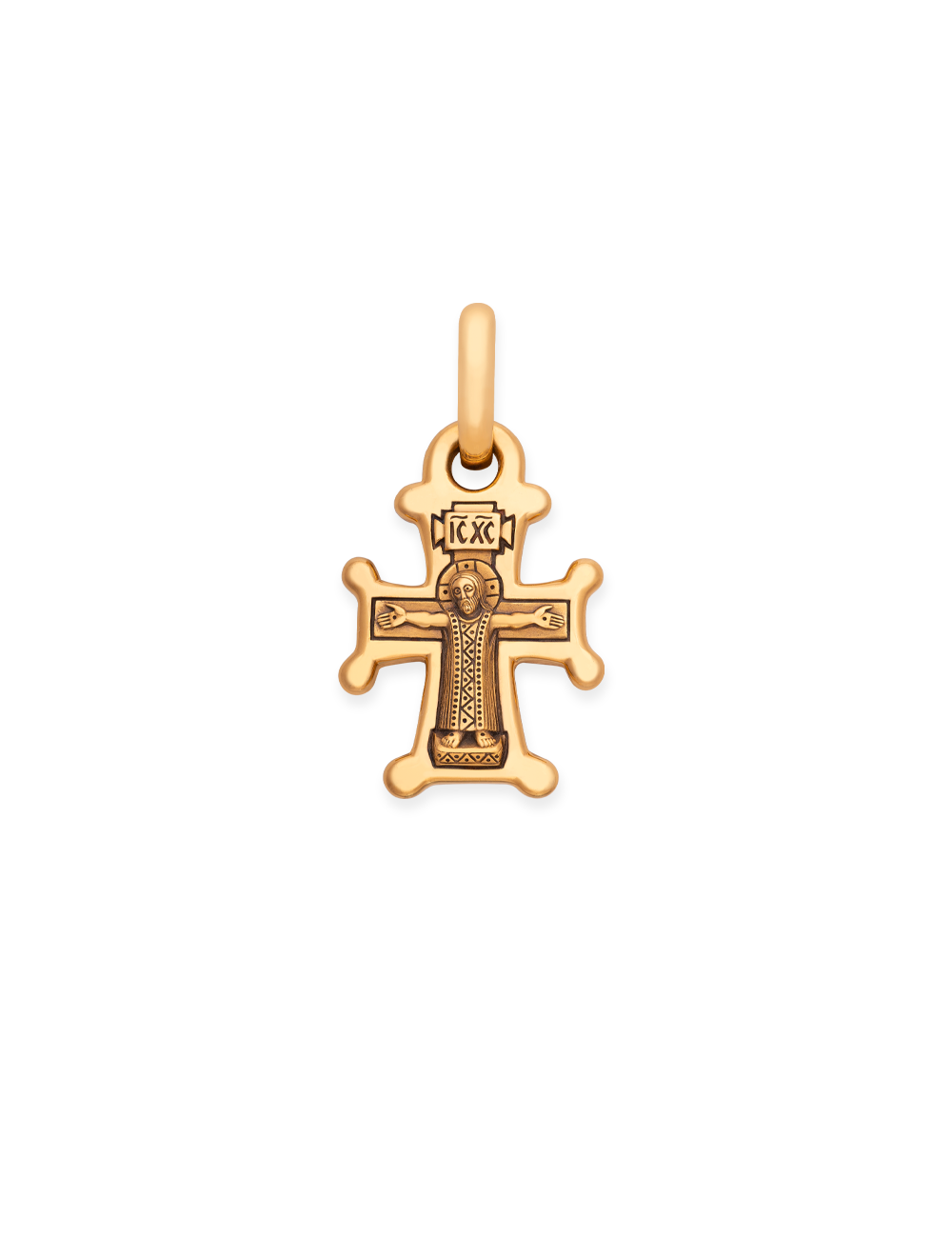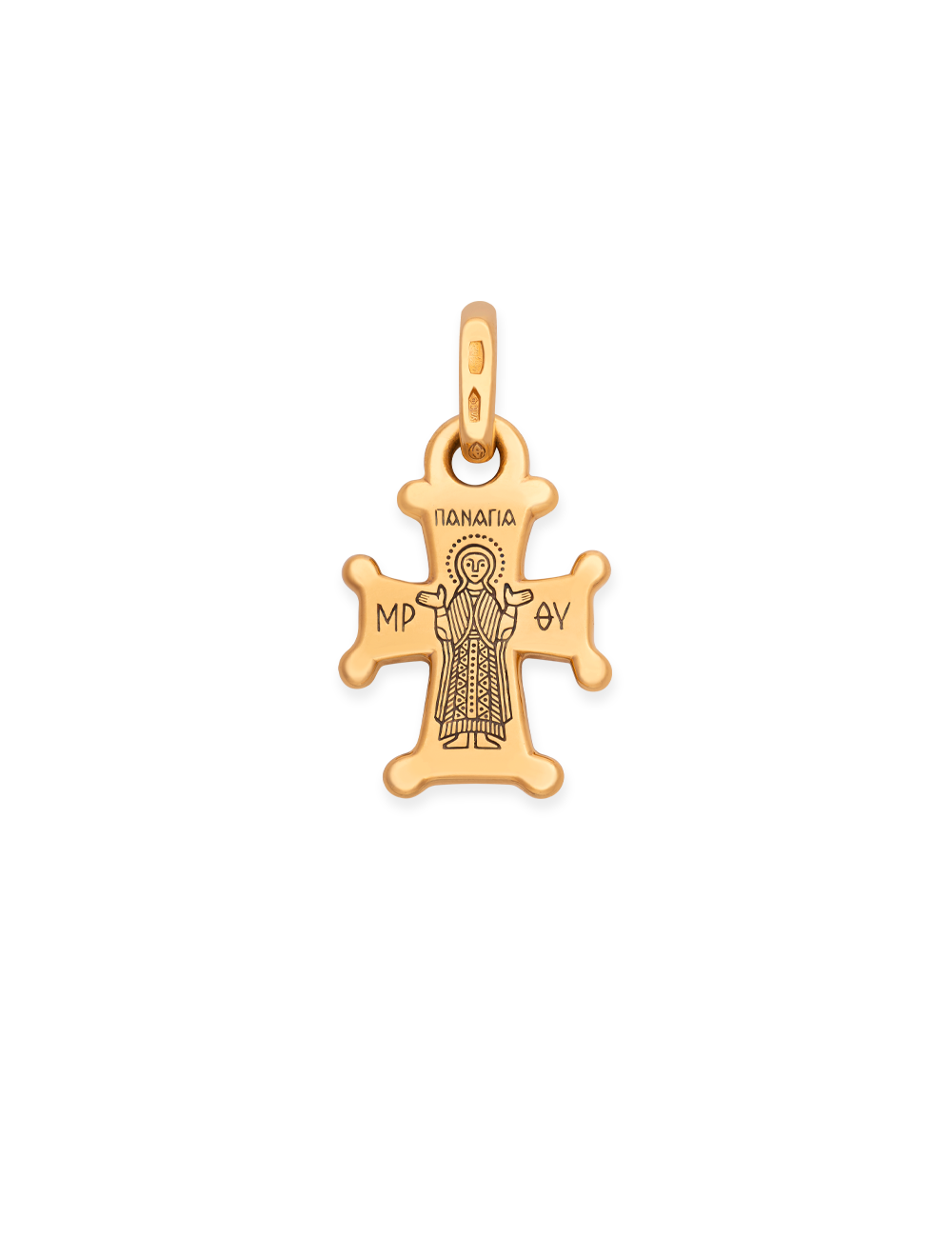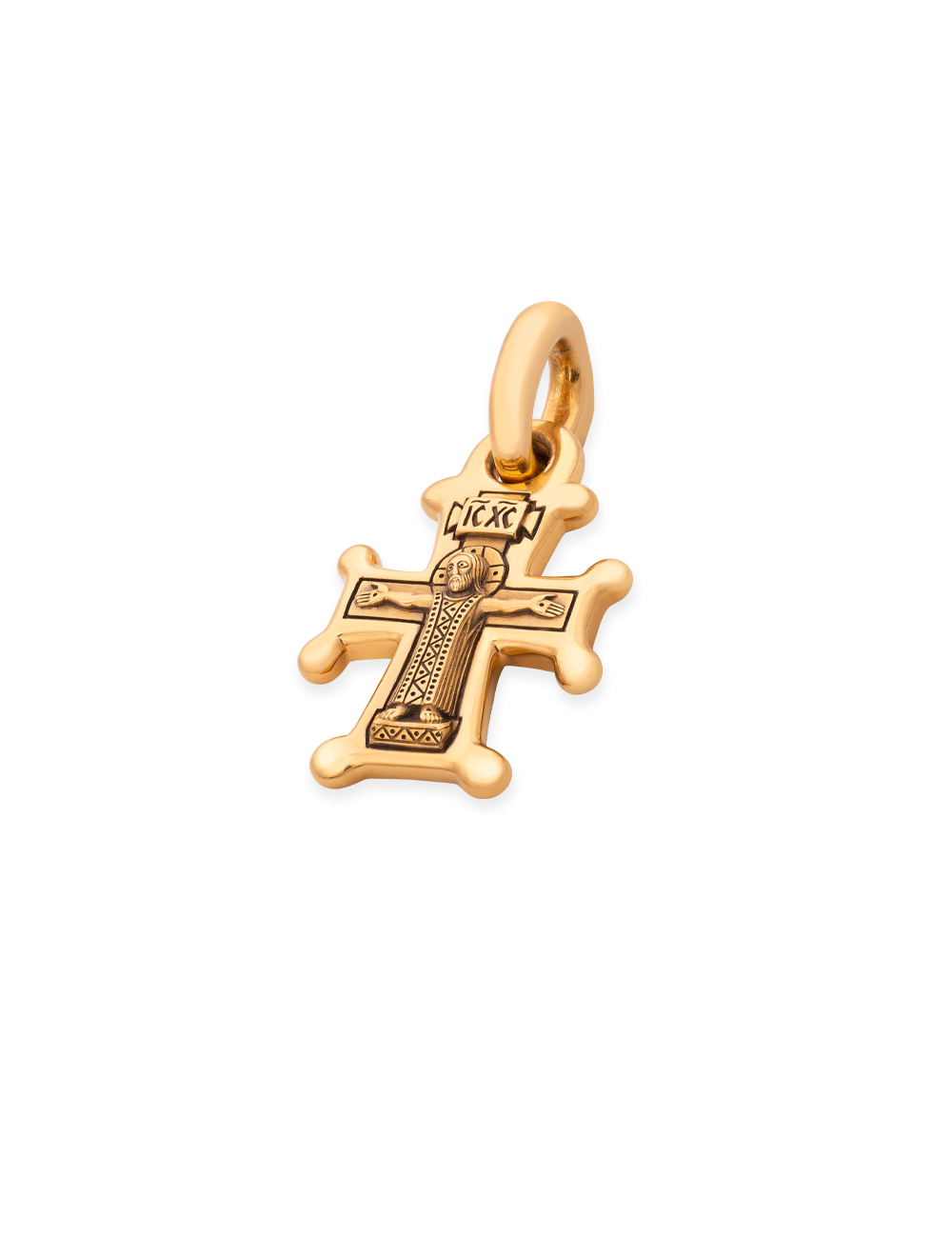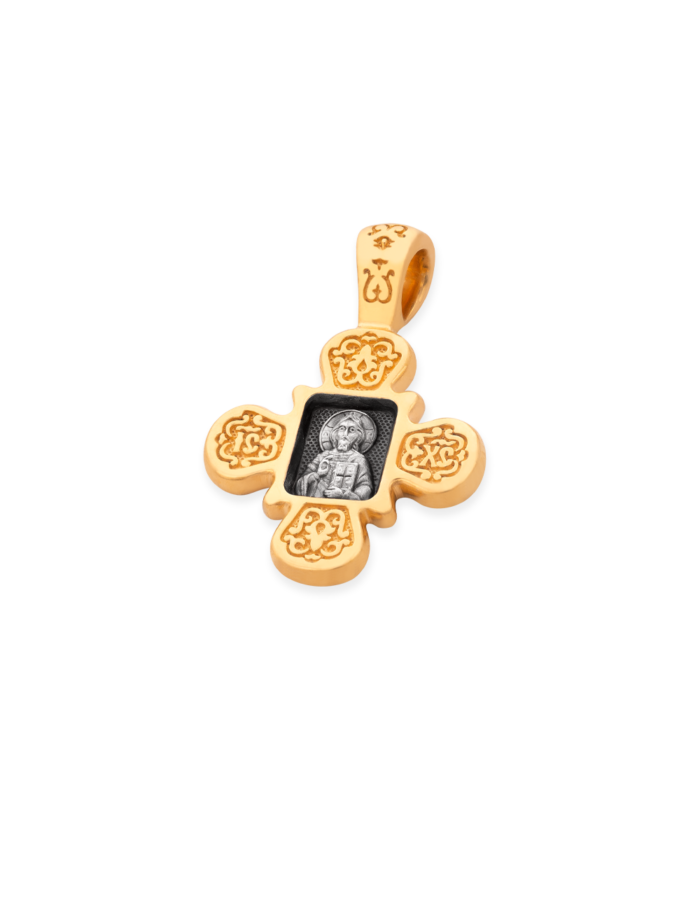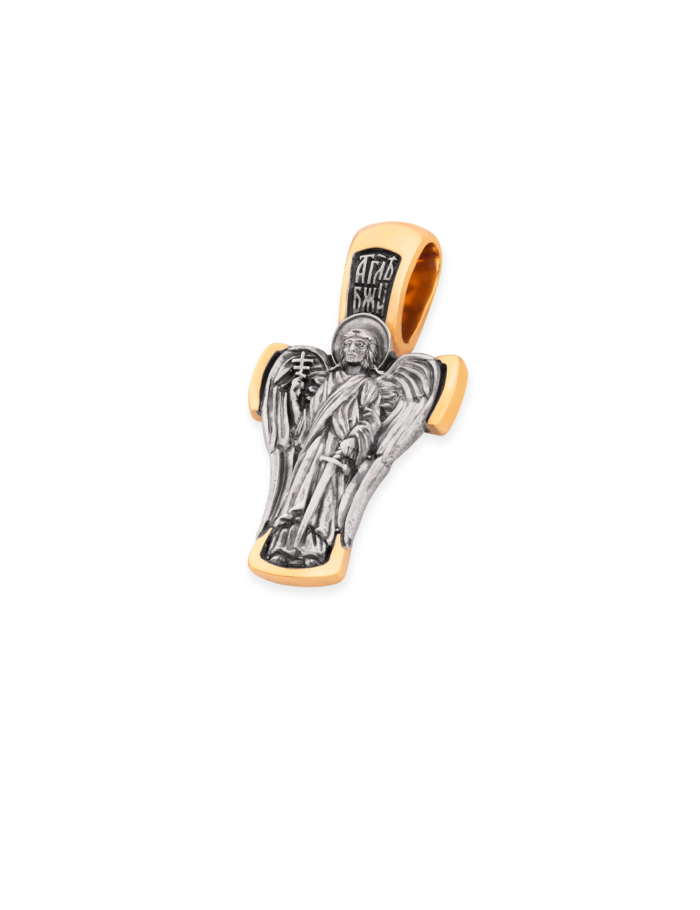Description
Size: 28 × 15 mm / 1.10 × 0.59 in
Weight: ~ 4.0 g / 0.14 ozCross pendant “Crucifixion. Theotokos Oranta” (Syrian version)
This gilded silver is distinguished by its stylized imagery, with the proportions of Christ and Mary resembling those of children. This, along with the small size, makes it an excellent choice ...of gift for an infant’s baptism. However, the symbolism of the cross “Crucifixion. Theotokos Oranta (Syrian version)” is relevant for every Christian. The child-like figure of Christ reminds us that the Savior deliberately became small to save mankind. As Christians, we are called to follow His example and to receive His Kingdom “as little children”.
Being small and elegant, the pendant is convenient to wear both over or under one’s clothes and is suitable for any occasion.
The symbolism of the cross pendant “Crucifixion. Theotokos Oranta” (Syrian version)
This small four-pointed cross with a movable top part mirrors the so-called “Syrian” encolpia made in the 10th – 11th centuries.
These crosses had widening bars and engraved images of saints in the Orans (prayerful) posture, most often the Virgin Oranta. They were allegedly produced in the Syrian-Palestinian region and were widespread in Byzantium. Owing to pilgrimage, they could sometimes be encountered in Europe and the Kyiv Rus. Our item follows this ancient tradition.
The bars widen from the center outwards and their edges have droplet-shaped extensions, often referred to in Russia as “teardrops”. The vertical bar finishes in a circle with a large hole, which is used to attach a ring. Crosses in this shape without any iconographic images were known in the Christian East from the 5th century.
The front contains a relief icon of the Crucifixion. The icon is executed in a style that was common in Byzantium in the 6th – 10th centuries. The figure of the crucified Christ is straight, the eyes are open and His arms are spread out horizontally. The head is crowned with a cross-shaped nimbus and slightly inclined toward the left shoulder. Only the Cross behind the Savior’s back and the nail marks in His hands and feet remind us of the crucifixion. The Lord, having defeated death, stands on a three-dimensional foot, a symbol of His greatness. His outstretched arms appear to be beckoning everyone.
The cross is distinguished by the garments worn by Christ. Rather than the loincloth, we have grown accustomed to seeing today, He is wearing a colobium. The latter used to be a long sleeveless tunic decorated with geometric designs. The colobium had two claves, or vertical gold stripes, which stood for the wearer’s noble birth in antiquity. In the 6th – 10th centuries, during the peak of Byzantine art, virtually every Byzantine crucifixion showed Christ wearing a colobium. This was done to emphasize the triumph of the Lord, Who had conquered death and granted salvation to all people.
Our item follows the same tradition. The image of the Savior is that of the Triumphant Christ. His regal dignity and divine nature are at their most evident. Despite the outward signs of death, the figure of the Savior radiates grandeur and conveys Divine Peace rather than death. At the same time, God’s kenosis (deliberate self-abasement) is conveyed through the childlike proportions of Christ’s figure. This conveys the human helplessness and humility of the Savior. Besides, the Crucifixion, as the end of the Lord’s earthly path, is spiritually connected to its beginning, Christmas. This “eternal childlike quality of God” serves as an example for all people, for “whosoever shall not receive the kingdom of God as a little child, he shall not enter therein” (Mark 10:15). To a certain extent, this iconography may serve as a counterbalance to the one seen on modern westernized crucifixes. Its simplicity makes our thinking switch from rational to symbolic, helping us unite with Christ, God, and the Man.
The reverse of our cross depicts an engraved full-length image of the Theotokos Oranta, made in the style of Syrian and Palestinian encolpia. Next to the icon one can find the traditional Greek inscriptions: ПАНАГIА (“The All-Holy”) and М7Р F7µ (“Mother of God”). These names confirm the Church dogma about the veneration of the Virgin Mary as the Mother of God. According to St. John of Damascus, “this name contains the entire mystery of the Incarnation”, and, as a result, reflects the “one incarnation (hypostasis) and two natures of our Lord Jesus Christ”. Therefore, the image of the Theotokos along with inscriptions of Her names are often placed on the back of cross pendants. They point at the unified dual nature of Christ, and, in doing so, fulfill an important dogmatic task.
Technical details of cross pendant “Crucifixion. Theotokos Oranta” (Syrian version)
The cross pendant is made from grade-925 sterling silver. The surface is fully plated with 24kt gold, whereas the etched outlines are blackened. Being quite small (1.10 × 0.59 in / 28 × 15 mm) and weighing about 0.14 oz (4 g), the pendant can be worn comfortably at all times.
About Master Jeweler Yuri Feodorov
Yuri Feodorov has spent over 35 years working with small sculptural items of an iconographic nature. He has created several collections of personally sacred items produced using a special casting technique, including cross pendants, scapular, and foldable icons. In addition, the artist has studied ancient Russian and Byzantine art and participated in archaeological expeditions and thematic exhibitions of Orthodox artwork.
Y. Feodorov’s collection is constantly exhibited at jewelry exhibitions and exhibitions of Orthodox items in Russia and abroad.
The artist’s work has received numerous awards, including several orders from the Carl Faberge Memorial Foundation. Y. Feodorov has repeatedly received incentives from the Russian Orthodox Church and the Ministry of Culture of the Russian Federation and won prizes at various exhibitions and contests.
It is important to mention that this item is made in Y. Feodorov’s workshops and together with the hallmark imprinted on the item it also has the passport of authenticity (shown in the picture).







